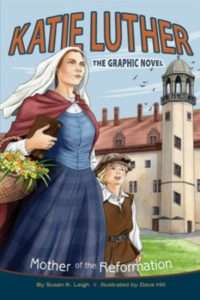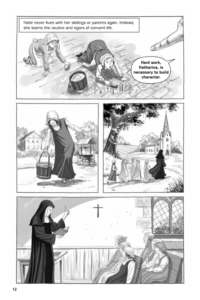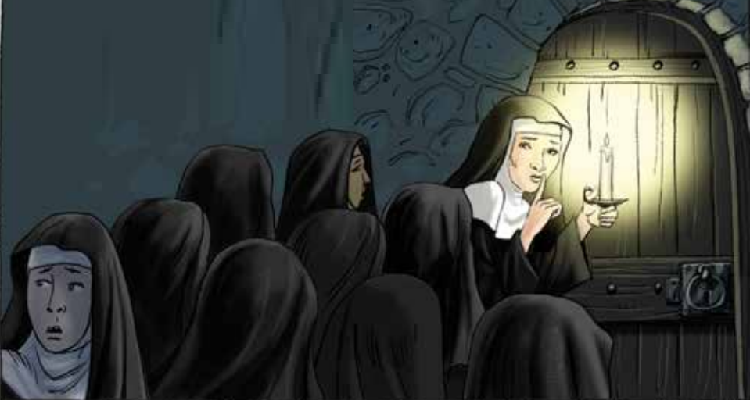Learn about Martin Luther’s influential wife in Katie Luther: Mother of the Reformation (Concordia Publishing House), a comic book biography of Katharina von Bora Luther. Written by Susan K. Leigh and illustrated by Dave Hill, this comic shows how Katie blazed her own trail at a time when there were very few options for women. In this exclusive Q&A, Susan shares why the Reformation is still relevant today, why it’s important for readers to meet the “mother” of the Reformation, and the unique challenges of bringing her to life in comic book form…
Q: WITH 2017 BEING THE ANNIVERSARY OF THE REFORMATION—WHY DO YOU THINK IT’S STILL SO RELEVANT TO YOUNG READERS TODAY?
If the books being published, programs on cable television, and websites on the internet are any indication, then people are fascinated with history in general and this period in history in particular. We love to learn. We love to learn from and about history. But I think the Reformation is relevant to today’s young readers because it shows how a few dedicated people can change the world. It teaches that God’s truth is always relevant and that sin will always fall when confronted with that truth.
An interesting aspect of the Reformation that makes it pertinent to young readers is that it was accelerated by technology; that is the technological advances in printing that helped to spread the movement and the Scriptures throughout Europe.
Q: WHY IS IT IMPORTANT FOR READERS TO GET TO KNOW THE “MOTHER” OF THE REFORMATION?
 It’s important for young readers get to know the mother of the reformation so they can understand that our Lord has designed individuals and His church to include many different types of people to accomplish His work on earth and that all of God’s children have vocations that are equally important. The book is not meant to further the feminist movement, though. It is intended to teach about a significant historical figure—a wife and mother who still serves as the model of the Christian woman.
It’s important for young readers get to know the mother of the reformation so they can understand that our Lord has designed individuals and His church to include many different types of people to accomplish His work on earth and that all of God’s children have vocations that are equally important. The book is not meant to further the feminist movement, though. It is intended to teach about a significant historical figure—a wife and mother who still serves as the model of the Christian woman.
Q: WHAT KIND OF RESEARCH WAS REQUIRED FOR THIS ADAPTATION OF HER STORY?
Well, first, I read a lot! There are only a handful of books about Katherina von Bora, and I think I read every one of them available in English (including one or two that are no longer in print). I also had done a lot of reading and researching about Martin Luther for Echoes of the Hammer (Concordia Publishing House), the graphic novel I wrote about him. In addition to reading books about these people, I read a lot of online articles about Germany—its geography, history, government, architecture. I researched how people lived: their households, food, pastimes, clothing; and how they spent their days, what kind of education they received.
One of the topics I researched extensively was the German Catholic Church in the late 1400s and early 1500s, as Katie was a nun for the first third of her life. Of particular interest to me was how nuns worked to maintain their homes and earn income for their cloisters. They were exceptionally hard-working and resourceful women.
Q: WHAT WERE THE UNIQUE CHALLENGES OF ADAPTING HER LIFE TO THE COMIC BOOK FORMAT?
It was two-fold, really. First, there isn’t a lot of information about Katie’s early life, so I had to fill in some gaps with general information (about how convents functioned, for example). But the other challenge is that while there isn’t a lot of detail known about her daily life, the format and page count of the book dictated how much I could share. There isn’t space to write a lot, so the information had to be presented in just a few sentences that fit with the illustrations. In just a few pages, the book tells her entire life story and how it intersected with a movement (the Reformation) that resulted in a sea change for all of Europe—and, ultimately, for the Americas as well. I had to be very selective in the amount of information the book could provide.
Q: WHAT WAS THE PROCESS LIKE COLLABORATING WITH ILLUSTRATOR DAVE HILL?
 This was the second time I’ve worked with Dave Hill to write and deliver a graphic novel. He is wonderful to work with—very accommodating and timely. And he offers excellent solutions to presenting a lot of information in the form of illustration. That’s what makes a great illustrator, by the way.
This was the second time I’ve worked with Dave Hill to write and deliver a graphic novel. He is wonderful to work with—very accommodating and timely. And he offers excellent solutions to presenting a lot of information in the form of illustration. That’s what makes a great illustrator, by the way.
Graphic novels tell a story using both words and pictures. This is an active way to tell a story, and it requires a lot of back and forth between the author and the illustrator to get it just right. So Dave and I wrote and illustrated this book, and the one about Martin Luther, using a circular process. First, I created a pagination chart for the book. That means, I decided what would go on each page. Then, I created a timeline of Katie’s life to fit that pagination chart. The next step was to work with the book’s graphic designer to finalize what each page would look like—would it be a text-only page, or would it have one panel, or six, or … ? This serves to further define the story and how it will play out throughout the book. That’s when we brought in Dave to begin to sketch the scenes.
Dave used my outline and art direction to draw sketches for the pages that would have illustrations. Once the graphic designer had received all of his sketches, she handed the project over to me to finish writing the text to fit in the space we allowed for it. When I had finished writing, the designer sent everything back to Dave (who lives in Scotland) and he created the final illustrations. Then, when all of the final art was in place, it all came back to me again. I edited and revised the text until I was satisfied that it was complete.
Along the way, the publisher had a fact checker, copyeditor, and proofreader review the illustrations and the text. The whole process took almost a year!


